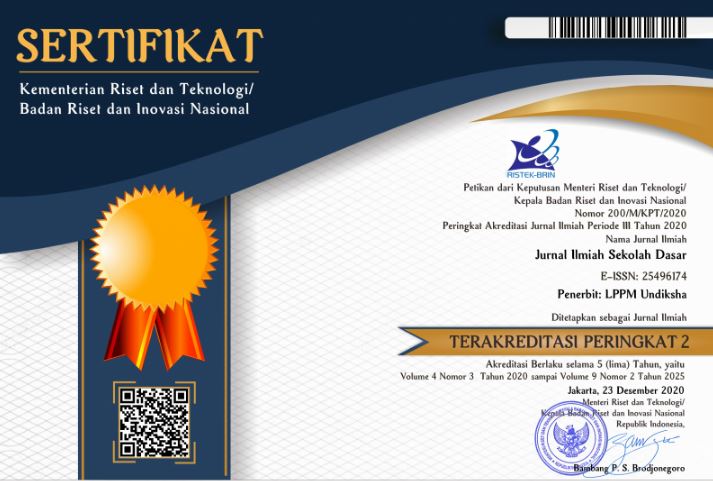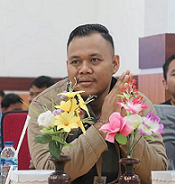Elementary School Students' Learning Styles: Perspective of Creative Thinking Skills
DOI:
https://doi.org/10.23887/jisd.v8i2.68385Keywords:
Creative Thinking, Learning Styles, Elementary School, StudentsAbstract
Learning styles can help students enhance their creative thinking abilities. However, the teacher did not modify the learning style during the learning process, therefore students’ creative thinking abilities did not meet expectations. This study aims to analyze elementary school children's learning styles from the standpoint of creative thinking skills. This is a descriptive quantitative research approach using a survey study design. The sample for this research was fourth-grade elementary school students. The tools used to collect data included tests, questionnaires, and observations. Descriptive statistics were used to analyze the data. According to the findings of this study, children with a visual learning style have high levels of creative thinking. As a result, this study reveals that every kid may develop creative thinking abilities ideally with learning that can adjust to individuals' learning styles. The findings of this study may help to improve students' creative thinking skills and serve as one of the answers for teachers in selecting learning models or approaches based on students' learning styles. Future studies should evaluate the efficacy of strategies or models for improving pupils' creative talents. Aside from that, it is feasible to create media, models, and textbooks to help primary school children strengthen their creative thinking skills.
References
Agustinaningsih, W. (2020). Profil Kreativitas Calon Guru Fisika Dengan Manajemen Pembelajaran Berbasis Gaya Belajar. Jurnal Pendidikan Fisika, 8(1), 112. https://doi.org/10.24127/jpf.v8i1.2601. DOI: https://doi.org/10.24127/jpf.v8i1.2601
Astuti, A., Waluya, S. B., & Asikin, M. B. (2020). Instrumen Kemampuan Berpikir Kreatif Matematika untuk Siswa Kelas IV Sekolah Dasar. Musamus Journal of Primary Education, 3(1), 27–34. https://doi.org/10.35724/musjpe.v3i1.3117. DOI: https://doi.org/10.35724/musjpe.v3i1.3117
Azzahrah Putri, R., Magdalena, I., Fauziah, A., & Nur Azizah, F. (2021). Pengaruh Gaya Belajar terhadap Pembelajaran Siswa Sekolah Dasar. Cerdika: Jurnal Ilmiah Indonesia, 1(2), 157–163. https://doi.org/10.59141/cerdika.v1i2.26. DOI: https://doi.org/10.36418/cerdika.v1i2.26
Bernadi, R. M. A. (2017). Peningkatan kreativitas siswa kelas IV SD melalui pembelajaran tematik integratif dengan pendekatan open-ended. Jurnal Prima Edukasia, 5(1), 91–101. https://doi.org/10.21831/jpe.v5i1.7783. DOI: https://doi.org/10.21831/jpe.v5i1.7783
Bravo, E., Costillo, E., Bravo, J. L., Mellado, V., & Conde, M. del C. (2022). Analysis of prospective early childhood education teachers’ proposals of nature field trips: An educational experience to bring nature close during this stage. International Journal of Environmental & Science Education, 106(1), 172–198. https://doi.org/10.1002/sce.21689. DOI: https://doi.org/10.1002/sce.21689
Dewantara, A. harpeni, B, A., & Harnida, H. (2020). Teacher Creativity in Utilizing IT-Based Media in View of Student Learning Styles. Journal of Primary Education, 1(1), 15–28. http://ejournal.karinosseff.org/index.php/jswse/article/view/639.
Dilekçi, A., & Karatay, H. (2023). The effects of the 21st century skills curriculum on the development of students’ creative thinking skills. Thinking Skills and Creativity, 47, 101229. https://doi.org/10.1016/j.tsc.2022.101229. DOI: https://doi.org/10.1016/j.tsc.2022.101229
Ezzeddine, N., Hughes, J., Kaulback, S., Houk, S., Mikhael, J., & Vickery, A. (2023). Implications of understanding the undergraduate nursing students’ learning styles: A discussion paper. Journal of Professional Nursing, 49(September), 95–101. https://doi.org/10.1016/j.profnurs.2023.09.006. DOI: https://doi.org/10.1016/j.profnurs.2023.09.006
Firdausi, Y. N., & Asikin, M. (2018). Analisis Kemampuan Berpikir Kreatif Siswa Ditinjau dari Gaya Belajar pada Pembelajaran Model Eliciting Activities ( MEA ). PRISMA (Prosiding Seminar Nasional Matematika), 1, 239–247. https://journal.unnes.ac.id/sju/prisma/article/download/19582/9512.
Fitra, D. K. (2022). Pembelajaran Berdiferensiasi dalam Perspektif Progresivisme pada Mata Pelajaran IPA. Jurnal Filsafat Indonesia, 5(3), 250–258. https://doi.org/10.23887/jfi.v5i3.41249. DOI: https://doi.org/10.23887/jfi.v5i3.41249
Hadi, S., & Novaliyosi. (2019). TIMSS Indonesia (Trends in International Mathematics and Science Study). Prosiding Seminar Nasional & Call For Papers, 562–569. http://jurnal.unsil.ac.id/index.php/sncp/article/view/1096.
Hafizha, D., Ananda, R., & Aprinawati, I. (2022). Analisis Pemahaman Guru Terhadap Gaya Belajar Siswa Di Sdn 020 Ridan Permai. Jurnal Review Pendidikan Dasar : Jurnal Kajian Pendidikan Dan Hasil Penelitian, 8(1), 25–33. https://doi.org/10.26740/jrpd.v8n1.p25-33. DOI: https://doi.org/10.26740/jrpd.v8n1.p25-33
Handayani, P., Restuti, M., Jannah, M., Ramadhani, K., Subali, E., & Isnaeni, W. (2019). Exploring the Local Potential of Banyumas Regency to Improve the Creative Thinking Ability of Elementary School Students. Profesi Pendidikan Dasar, 1(1), 69–80. https://doi.org/10.23917/ppd.v1i1.7269. DOI: https://doi.org/10.23917/ppd.v1i1.7269
Hashim, A. M., Aris, S. R. S., & Fook, C. Y. (2022). Assessing Gender Differences in Creative Self-Efficacy, Creative Ability and Creative Environment Dimensions among Lower Secondary School Students in Selangor, Malaysia. Asian Journal of University Education, 18(4), 879–892. https://doi.org/10.24191/ajue.v18i4.19993. DOI: https://doi.org/10.24191/ajue.v18i4.19993
Hidayati, L., & Sujarwati, I. (2023). The Differentiated Learning Strategy in Implementation Merdeka Belajar Curriculum to Improve Students’ Learning Outcomes of English Lesson in Elementary School. Cendikia : Media Jurnal Ilmiah Pendidikan, 13(5), 724–733. http://iocscience.org/ejournal/index.php/Cendikia/article/view/3668.
Huang, C. L., Luo, Y. F., Yang, S. C., Lu, C. M., & Chen, A. S. (2020). Influence of Students’ Learning Style, Sense of Presence, and Cognitive Load on Learning Outcomes in an Immersive Virtual Reality Learning Environment. Journal of Educational Computing Research, 58(3), 596–615. https://doi.org/10.1177/0735633119867422. DOI: https://doi.org/10.1177/0735633119867422
Irawati, I., Ilhamdi, M. L., & Nasruddin, N. (2021). Pengaruh Gaya Belajar Terhadap Hasil Belajar IPA. Jurnal Pijar Mipa, 16(1), 44–48. https://doi.org/10.29303/jpm.v16i1.2202. DOI: https://doi.org/10.29303/jpm.v16i1.2202
Irbah, D. A., Kusumaningsih, W., & Sutrisno, S. (2019). Analisis Kemampuan Berpikir Kreatif Matematis Ditinjau Dari Gaya Belajar Siswa. Media Penelitian Pendidikan : Jurnal Penelitian Dalam Bidang Pendidikan Dan Pengajaran, 12(2), 115. https://doi.org/10.26877/mpp.v12i2.3829. DOI: https://doi.org/10.26877/mpp.v12i2.3829
Ismail, Suwarsono, S., & Lukito, A. (2018). Critical Thinking Skills of Junior High School Female Students with High Mathematical Skills in Solving Contextual and Formal Mathematical Problems. Journal of Physics: Conference Series, 953(1). https://doi.org/10.1088/1742-6596/953/1/012205. DOI: https://doi.org/10.1088/1742-6596/953/1/012205
Kin, T. M., & Kareem, O. A. (2019). School leaders’ Competencies that make a difference in the Era of Education 4.0: A Conceptual Framework. International Journal of Academic Research in Business and Social Sciences, 9(4). https://doi.org/10.6007/ijarbss/v9-i4/5836. DOI: https://doi.org/10.6007/IJARBSS/v9-i4/5836
Kurnia, A., Sukarmin, & Sunarno, W. (2021). Profil Kemampuan Berpikir Kreatif Siswa Menggunakan Soal Tes Pilihan Ganda pada Pembelajaran Ilmu Pengetahuan Alam. Indonesian Journal of Educational Science (IJES), 4(1), 27–32. https://doi.org/10.31605/ijes.v4i1.1147. DOI: https://doi.org/10.31605/ijes.v4i1.1147
Lailatul Alifah, & Sukartono. (2023). Integration of 21st Century Skills in Thematic Learning in Elementary School. Jurnal Ilmiah Sekolah Dasar, 7(1), 168–175. https://doi.org/10.23887/jisd.v7i1.55050. DOI: https://doi.org/10.23887/jisd.v7i1.55050
Lampropoulos, G., Siakas, K., & Anastasiadis, T. (2019). Internet of Things in the Context of Industry 4.0: An Overview. International Journal of Entrepreneurial Knowledge, 7(1), 4–19. https://doi.org/10.2478/ijek-2019-0001. DOI: https://doi.org/10.2478/ijek-2019-0001
Lestari, S., & Widda Djuhan, M. (2021). Analisis Gaya Belajar Visual, Audiotori dan Kinestetik dalam Pengembangan Prestasi Belajar Siswa. JIIPSI: Jurnal Ilmiah Ilmu Pengetahuan Sosial Indonesia, 1(1), 79–90. https://doi.org/10.21154/jiipsi.v1i2.250. DOI: https://doi.org/10.21154/jiipsi.v1i2.250
Magulod, G. C. (2019). Learning styles, study habits and academic performance of Filipino university students in applied science courses: Implications for instruction. Journal of Technology and Science Education, 9(2), 184–198. https://doi.org/10.3926/jotse.504. DOI: https://doi.org/10.3926/jotse.504
Marzuki, Asih, E. C. M., & Wahyudin. (2019). Creative thinking ability based on learning styles reviewed from mathematical communication skills. Journal of Physics: Conference Series, 1315(1). https://doi.org/10.1088/1742-6596/1315/1/012066. DOI: https://doi.org/10.1088/1742-6596/1315/1/012066
Maylina Primusti Sari, & Abadi, A. P. (2022). Pengaruh Gaya Belajar terhadap Kemampuan Berpikir Kreatif Matematis Siswa SMK Muhammadiyah 4 The Influence of Learning Styles on Mathematical Creative Thinking Skills of SMK Muhammadiyah 4 ‘ s Students. Prosiding Sesiomadika, 168–178. https://journal.unsika.ac.id/index.php/sesiomadika/article/view/7670.
Ms, M. (2023). Pembelajaran Berdiferesiasi Dan Penerapannya. SENTRI: Jurnal Riset Ilmiah, 2(2), 533–543. https://doi.org/10.55681/sentri.v2i2.534. DOI: https://doi.org/10.55681/sentri.v2i2.534
Muharrima, F., & Manoy, J. T. (2021). Scaffolding Sesuai Gaya Belajar Terhadap Kemampuan Berpikir Kreatif Matematis Siswa SMP dalam Menyelesaikan Soal HOTS. MATHEdunesa, 10(1), 162–171. https://doi.org/10.26740/mathedunesa.v10n1.p162-171. DOI: https://doi.org/10.26740/mathedunesa.v10n1.p162-171
Mukti, A. A. B., & Soedjoko, E. (2021). Kemampuan Siswa pada Aspek Berpikir Kreatif Ditinjau dari Gaya Belajar Melalui Pembelajaran Problem Posing Berbasis Open-Ended Problem. PRISMA, Prosiding Seminar Nasional, 4, 26–36. https://journal.unnes.ac.id/sju/prisma/article/view/44955.
Murdiana, Rahmat Jumri, & Boby Engga Putra Damara. (2020). Pengembangan Kreativitas Guru dalam Pembelajaran Kreatif. Jurnal Pendidikan Matematika Raflesia, 5(2), 153–160. https://doi.org/10.33369/jpmr.v5i2.11450.
Musaidah, E., Purnomo, D., & Setyowati, R. D. (2020). Analisis Kemampuan Berpikir Kreatif Ditinjau dari Gaya Belajar Siswa Kelas VIII SMP Negeri 1 Sayung Tahun 2019/2020. Imajiner: Jurnal Matematika Dan Pendidikan Matematika, 2(5), 382–390. https://doi.org/10.26877/imajiner.v2i5.6520. DOI: https://doi.org/10.26877/imajiner.v2i5.6520
Muslicha, A. (2015). Metode Pengajaran Dalam Pendidikan Lingkungan Hidup Pada Siswa Sekolah Dasar (Studi Pada Sekolah Adiwiyata Di Dki Jakarta). Jurnal Pendidikan, 16(2), 110–126. https://doi.org/10.33830/jp.v16i2.342.2015. DOI: https://doi.org/10.33830/jp.v16i2.342.2015
Ningrum, M., Maghfiroh, & Andriani, R. (2023). Kurikulum Merdeka Belajar Berbasis Pembelajaran Berdiferensiasi di Madrasah Ibtidaiyah. EL Bidayah: Journal of Islamic Elementary Education, 5(1), 85–100. https://doi.org/10.33367/jiee.v5i1.3513. DOI: https://doi.org/10.33367/jiee.v5i1.3513
Octaviana, D., & Kurniasih, A. W. (2020). Mathematical Creative Thinking Skills of Eight Grade in Terms of Learning Styles on Learning Model Means-Ends Analysis (MEA). Unnes Journal of Mathematics Education, 9(1), 74–82. https://doi.org/10.15294/ujme.v9i1.38104.
Porter, B. De, Hernacki, M., & Abdurrahman, A. (2015). Quantum learning : membiasakan belajar nyaman dan menyenangkan / Bobbi De Porter & Mike Hernacki ; penerjemah, Alwiyah Abdurrahman. Kaifa Learning.
Putri Ningrat, S., Tegeh, I. M., & Sumantri, M. (2018). Kontribusi Gaya Belajar Dan Motivasi Belajar Terhadap Hasil Belajar Bahasa Indonesia. Jurnal Ilmiah Sekolah Dasar, 2(3), 257. https://doi.org/10.23887/jisd.v2i3.16140. DOI: https://doi.org/10.23887/jisd.v2i3.16140
Rhosaliana, A., Ulia, N., & Cahyaningtyas, A. P. (2021). Analisis Kemampuan Pemahaman Konsep dan Berpikir Kreatif Matematis Peserta Didik dalam Penyelesaian Soal Bangun Ruang Kelas VI SD Negeri Kedalingan 01. Prosiding Konstelasi Ilmiah Mahasiswa Unissula (KIMU) 5, 195–205. https://jurnal.unissula.ac.id/index.php/kimuhum/article/view/17622.
Rini, D. S., Adisyahputra, & Sigit, D. V. (2020). Boosting student critical thinking ability through project based learning, motivation and visual, auditory, kinesthetic learning style: A study on Ecosystem Topic. Universal Journal of Educational Research, 8(4A), 37–44. https://doi.org/10.13189/ujer.2020.081806. DOI: https://doi.org/10.13189/ujer.2020.081806
Sa’adah, A. N., Nizaruddin, N., & Rahmawati, N. D. (2019). Analisis Kemampuan Berpikir Kreatif Siswa dalam Pembelajaran Matematika Ditinjau dari Gaya Kognitif Reflektif Siswa. Imajiner: Jurnal Matematika Dan Pendidikan Matematika, 1(5), 217–223. https://doi.org/10.26877/imajiner.v1i5.4472. DOI: https://doi.org/10.26877/imajiner.v1i5.4472
Sekar., D. K. S., Pudjawan, K., Margunayasa, I. G. (2015). Analisis Kemampuan Berpikir Kreatif dalam Pembelajaran IPA Pada Siswa Kelas IV di SD Negeri 2 Pemaron Kecamatan Buleleng. MIMBAR PGSD Undiksha, 3(1). https://doi.org/10.23887/jjpgsd.v3i1.5823.
Supit, D., Melianti, M., Lasut, E. M. M., & Tumbel, N. J. (2023). Gaya Belajar Visual, Auditori, Kinestetik terhadap Hasil Belajar Siswa. Journal on Education, 5(3), 6994–7003. https://doi.org/10.31004/joe.v5i3.1487. DOI: https://doi.org/10.31004/joe.v5i3.1487
Suryandari, K. C., Rokhmaniyah, & Joharman. (2020). Development of Subject Specific Pedagogy (SSP) Based on the Scientific Reading Based Project (SRBP) Model Empowering Critical and Creative Thinking Skills. Proceedings of the International Joint Conference on Arts and Humanities (IJCAH 2020) Development, 491, 468–474. https://doi.org/10.2991/assehr.k.201201.084. DOI: https://doi.org/10.2991/assehr.k.201201.084
Suryandari, K., Sajidan, P., Budi, S., & Kun, Z. (2017). Effectiveness of Project Based Learning on Empowerment Critical Thinking Skill toward Preservice Teacher on Primary Teacher Education Program. International Conference on Teacher Training and Education 2017 (ICTTE 2017), 158, 399–407. https://doi.org/10.2991/ictte-17.2017.58. DOI: https://doi.org/10.2991/ictte-17.2017.58
Wahyuni, I. (2022). Analisis Kemampuan Literasi Numerasi Berdasarkan Gaya Belajar pada Anak Usia Dini. Jurnal Obsesi : Jurnal Pendidikan Anak Usia Dini, 6(6), 5840–5849. https://doi.org/10.31004/obsesi.v6i6.3202. DOI: https://doi.org/10.31004/obsesi.v6i6.3202
Wibowo, N. (2016). Upaya Peningkatan Keaktifan Siswa Melalui Pembelajaran Berdasarkan Gaya Belajar Di Smk Negeri 1 Saptosari. Elinvo (Electronics, Informatics, and Vocational Education), 1(2), 128–139. https://doi.org/10.21831/elinvo.v1i2.10621. DOI: https://doi.org/10.21831/elinvo.v1i2.10621
Winiarsih, I., Hakim, A. R., & Sari, N. I. (2021). Analisis Kemampuan Berpikir Kreatif Matematis dalam Menyelesaikan Soal Matriks Ditinjau dari Gaya Belajar. Jurnal Pendidikan Teknik, 2(1), 139–146. https://www.siducat.org/index.php/jpt/article/view/254. DOI: https://doi.org/10.31002/mathlocus.v2i1.1513
Yaniawati, P., Kariadinata, R., Sari, N., Pramiarsih, E., & Mariani, M. (2020). Integration of e-learning for mathematics on resource-based learning: Increasing mathematical creative thinking and self-confidence. International Journal of Emerging Technologies in Learning (IJET, 15(6), 60–78. learntechlib.org/p/217189/. DOI: https://doi.org/10.3991/ijet.v15i06.11915
Yotta, E. G. (2023). Accommodating students’ learning styles differences in English language classroom. Heliyon, 9(6), 1–7. https://doi.org/10.1016/j.heliyon.2023.e17497. DOI: https://doi.org/10.1016/j.heliyon.2023.e17497
Downloads
Published
How to Cite
Issue
Section
License
Copyright (c) 2024 Nur Hidayah, Gunarhadi, Karsono

This work is licensed under a Creative Commons Attribution-ShareAlike 4.0 International License.
Authors who publish with the Journal Ilmiah Sekolah Dasar agree to the following terms:
- Authors retain copyright and grant the journal the right of first publication with the work simultaneously licensed under a Creative Commons Attribution License (CC BY-SA 4.0) that allows others to share the work with an acknowledgment of the work's authorship and initial publication in this journal.
- Authors are able to enter into separate, additional contractual arrangements for the non-exclusive distribution of the journal's published version of the work (e.g., post it to an institutional repository or publish it in a book), with an acknowledgment of its initial publication in this journal.
- Authors are permitted and encouraged to post their work online (e.g., in institutional repositories or on their website) prior to and during the submission process, as it can lead to productive exchanges, as well as earlier and greater citation of published work. (See The Effect of Open Access)










